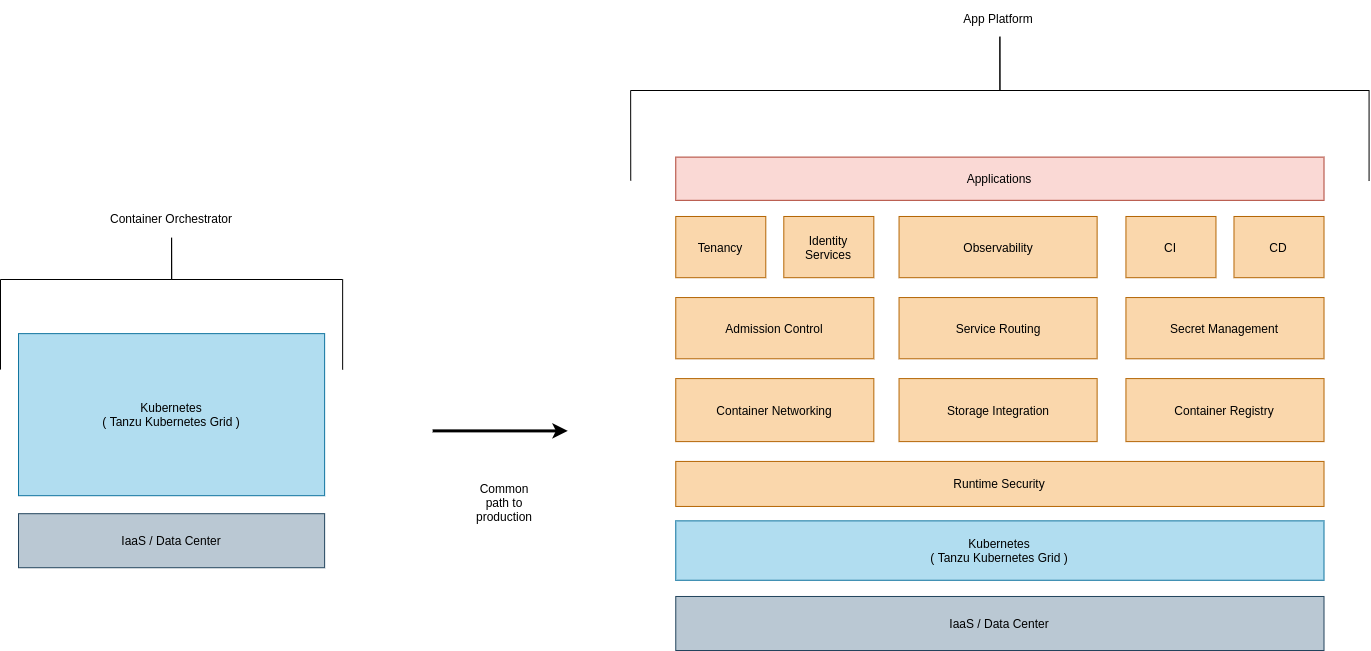RPK demonstrates an end-to-end application platform running on top of Kubernetes. For RPK, an application platform is defined as a viable place for running production workloads. This is achieved by instantiating a workload orchestrator (Kubernetes) and running platform services on top to provide applications what they need to be successful in production. Technical decisions made in RPK can be used, ignored, replaced, or mutated based on your unique infrastructure needs. RPK includes a reference implementation and documentation.
-
Reference Implementation: Modular automation enabling you to deploy various platform services atop a Kubernetes cluster. For example, admission control systems or service routing systems.
-
Documentation: The documentation for RPK includes two types of assets. The Architecture Guide covers each module and how it architecturally interacts with other components in the system. This enables the reader to understand how RPK has made technical decisions and to ultimately adopt or build on those decisions. Another is guides for cluster operators and developers. Cluster operations discuss how to use and interact with various platform services. The developer guides discuss application onboarding considerations to enable platform adoption.
Kubernetes is the ubiquitous means for orchestrating containerized workloads. However, the path to production with Kubernetes is often misunderstood. Specifically, Kubernetes itself is rarely a viable place to run production workloads. Instead it provides a solid foundation for platform teams to deploy or build an application platform. Instead of viewing Kubernetes as a next-generation platform, we consider it to be the base to build on.
The above represents this common delta. For most, running Kubernetes in production means defining, architecting, and implementing a specific application platform solution. There is variance depending on the organization and it's maturity and team dynamics. For example, many platform teams wish to offer fully integrated secret management solutions, taking the onus off application developers to re-implement this logic in every application and ensure security best practices are followed. However, other teams may choose to not solve this concern at the platform level. This proves the end results has significant variance per company. A key component to Kubernetes success is the flexibility/extensibility to support these organizational preferences. RPK acts as a reference implementation demonstrating these application platform concerns. However, it is expected consumers of RPK will customize it to fit their needs.
RPK approaches the building blocks (seen above in orange) by combining real-world experience and proven implementations delivered to customers. There is high variance in how customers approach each of these concerns, thus we take the most common paths seen and expect our approaches to evolve over time.
Kubernetes user needs fit on a spectrum, typically landing in one of 3 personas. Each persona envisions a slightly different path to production. We often identify these personas as foundational, advanced, and opinionated.
-
Foundational: I want an enterprise-grade Kubernetes distribution. This persona is largely interested in having the foundation poured but is not yet ready to build the house. In our experience, the path to production with the foundational persona is rarely achieved without moving on to one of the other below aspirations. However, the intent behind the implementation selection may be right for the customer at the time, especially when their production intentions are largely non-determined.
-
Advanced: I want to create a viable place to run applications in production with Kubernetes as the foundation. This persona not only wants to pour the foundation, but also help design, build, and operationalize an application platform on top - ensuring they end up with a habitable place for applications to live (i.e., running in production).
-
Opinionated: I want to deploy a fully-baked application platform that is ready for production. This persona wants to adopt hardened opinions of a vendor - similar to an established housing developer, they can have a quality, habitable, home built. This lowers the effort seen in the Advanced persona around architecting / building, although some extension may be involved.
No. The intention of RPK is to capture common implementations delivered in the field and make them automated and executable. This enables our architectures to evolve over time and be used in several contexts. RPK can be used for:
- Proof-of-Concepts
- Field implementations (as a starting point that you build atop of)
- Internal and External Enablement
-
RPK is intended to represent a reference implementation of what a modern application platform could look like. There are several other decisions that go into making an application platform "production ready". RPK is not intended to produce a production ready application platform, rather give an opinionated, sample view of what one may look like.
-
RPK is not supported by VMware. It is a tool that belongs to Tanzu Labs and is intended to be used by those who wish to get acquainted with Kubernetes and the decisions that go into producing a fully fledged application platform. Once again, the platform produced by RPK is a reference only and not intended to be production ready out of the box.
RPK (Reference Platform for Kubernetes), formerly referred to as "Project Ivy", is a VMware project that is developed and open sourced under the MIT License. View the license file and notice file in this repo for more information.
Please review our Code of Conduct prior to getting started at CODE-OF-CONDUCT.md
Interested in deploying? View the getting started guide to deploy RPK at docs/QUICKSTART.md
Interested in contributing? View the contributing guide at docs/CONTRIBUTING.md
Questions? Please feel free to open an issue or reach out to one of our core maintainers

